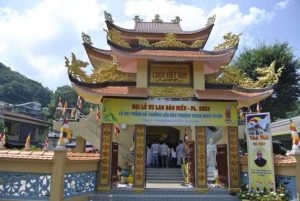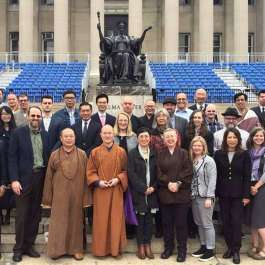
Korea’s annual Yeondeunghoe (연등회) festival of light, popularly known as the Lotus Lantern Festival and traditionally held in the spring to mark the birth of the Buddha, has once again illuminated central Seoul this month after being canceled for two consecutive years due to safety concerns during the ongoing pandemic.* The theme for this year’s lantern festival was the light of hope and healing in the post-pandemic era.
To celebrate the Buddha’s 2,566th birthday on 8 May, major Buddhist temples and the Cheonggye Stream area of downtown Seoul have been illuminated by thousands of delicate paper lotus lanterns. Although related events have been held since April, Yeondeunghoe proper ran for three days starting 6 May, with festivities and activities continuing through to Wednesday.
“We lit up the lantern statue at the plaza in front of Seoul City Hall on 5 April at 7pm to signal the start of this year’s event,” said an official from the Jogye Order of Korean Buddhism, Korea’s largest Buddhist order. “There will be various events until 11 May for both Koreans and foreigners to participate in as they wish to return to their ordinary lives with the end of the pandemic.” (Korea JoongAng Daily)

A host of colorfully glowing paper lanterns have been on display at Jogye Temple in central Seoul, Bongeun Temple in southern Seoul and around Cheonggye Stream in the downtown area since 29 April.
The annual Yeondeunghoe lantern parade, which usually sees more than 100,000 lanterns borne along a three-kilometer route through the streets of Seoul, has long been the traditional centerpiece of the festival, which also includes a variety cultural events, displays, and performances at Buddhist temples and public venues. Described as the largest festival of its kind in the world, visitors to the annual event have been recorded as exceeding 350,000, including local residents and tourists. The annual celebration can be interpreted as sharing the light of wisdom, compassion, and peace with the world, as well as hopes and wishes for happiness and social harmony.
In December 2020, Yeondeunghoe: Lantern Lighting Festival in the Republic of Korea, was confirmed as an intangible cultural heritage during the 15th session of the UNESCO Intergovernmental Committee for the Safeguarding of the Intangible Cultural Heritage.** South Korea is now home to 21 UNESCO intangible heritage assets, including ssireum (traditional Korean wrestling), kimjang (the making and sharing of kimchi), the folk song “Arirang,” the royal ancestral rites and ritual music of the Jongmyo shrine, and pansori narrative folk songs.
By assigning Intangible Cultural Heritage status, UNESCO aims to help protect traditions, knowledge, and skills that have been passed along through generations, so that they are not lost or forgotten with the passage of time.
“Lighting the lanterns . . . symbolizes enlightening the minds of individuals, communities, and all of society through [the] Buddha’s wisdom,” UNESCO explained. “The related knowledge and skills are mainly transmitted through Buddhist temples and communities, and the Yeondeunghoe Safeguarding Association plays a notable role through the organization of educational programs. The festival is a time of joy during which social boundaries are temporarily erased. In times of social difficulties, it plays a particularly important role in integrating society and helping people overcome the troubles of the day.” (UNESCO)
The lantern festival has a history that stretches back more than 1,200 years to Korea’s ancient Silla (신라) period (c. 57 BCE–935 CE). In the historical text Samguk Sagi (History of the Three Kingdoms), completed in 1145, during the Unified Silla kingdom (668–935), King Gyeongmun and Queen Jinseong visited Hwangnyong Temple to observe lanterns on the occasion of the first full moon of the year in 866 and 890.

Commemorations for the birth of Buddha, a public holiday in South Korea, are known as Bucheonim Osin Nal (부처님 오신 날) meaning “the day the Buddha came,” and Seokga Tansinil (석가탄신일), “the Buddha’s birthday.” The festival is observed on the eighth day of the fourth month of the lunar calendar, which usually falls during May, but last year fell on 30 April.
According to census data for 2015, the majority of South Korea’s population—56.1 per cent—holds no religious affiliation. Christians make up the largest religious segment of the population at 27.6 per cent, while Buddhists account for 15.5 per cent.
* Korean Buddhists Cancel Lotus Lantern Festival as Pandemic Caution Lingers (BDG)
** UNESCO Lists Korea’s Buddhist Lantern Festival as Intangible Cultural Heritage of Humanity (BDG)
See more
Yeon Deung Hoe
Yeondeunghoe, lantern lighting festival in the Republic of Korea (UNESCO)
Lotus lantern festival lights up after two-year break (The Korea Herald)
Seoul set to be lit up as lantern festival returns (Korea JoongAng Daily)
Related news reports from BDG
Buddhist Nun Teaches Sustainability at Stanford with Korean Temple Cuisine
Association of Korean Buddhist Orders Publishes Buddhist National Treasures of Korea
Korean Buddhist Monks Hold Conference Denouncing Perceived Discrimination












